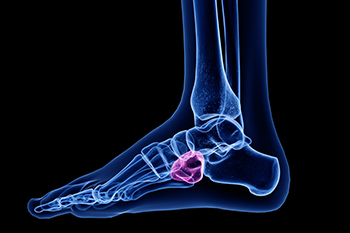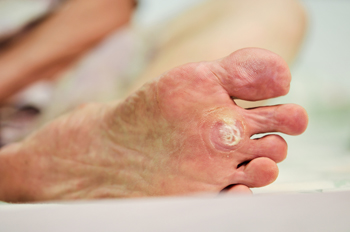Connect With Us
Blog
Items filtered by date: August 2024
Causes and Prevention Strategies of Workplace Falls

Falls in the workplace can occur due to various factors, such as wet or uneven floors, cluttered walkways, and inadequate lighting. Tasks that involve heights or slippery surfaces can also pose significant risks. To prevent these falls, it is essential to implement safety measures such as using appropriate personal protective equipment, or PPE, and slip-resistant footwear. PPE such as harnesses and helmets can protect workers from falls from heights, while slip-resistant footwear provides better traction on potentially hazardous surfaces. Additionally, maintaining a clean and organized work environment, ensuring proper lighting, and regularly inspecting floors and walkways contribute to a safer workplace. If you have sustained a fall while working and have injured your foot, it is suggested that you promptly schedule an appointment with a podiatrist who can treat various foot conditions.
Preventing falls among the elderly is very important. If you are older and have fallen or fear that you are prone to falling, consult with Mack Jay Groves IV, DPM from Practice. Our doctor will assess your condition and provide you with quality advice and care.
Every 11 seconds, an elderly American is being treated in an emergency room for a fall related injury. Falls are the leading cause of head and hip injuries for those 65 and older. Due to decreases in strength, balance, senses, and lack of awareness, elderly persons are very susceptible to falling. Thankfully, there are a number of things older persons can do to prevent falls.
How to Prevent Falls
Some effective methods that older persons can do to prevent falls include:
- Enrolling in strength and balance exercise program to increase balance and strength
- Periodically having your sight and hearing checked
- Discuss any medications you have with a doctor to see if it increases the risk of falling
- Clearing the house of falling hazards and installing devices like grab bars and railings
- Utilizing a walker or cane
- Wearing shoes that provide good support and cushioning
- Talking to family members about falling and increasing awareness
Falling can be a traumatic and embarrassing experience for elderly persons; this can make them less willing to leave the house, and less willing to talk to someone about their fears of falling. Doing such things, however, will increase the likelihood of tripping or losing one’s balance. Knowing the causes of falling and how to prevent them is the best way to mitigate the risk of serious injury.
If you have any questions, please feel free to contact our office located in Covington, LA . We offer the newest diagnostic and treatment technologies for all your foot care needs.
Understanding Cuboid Syndrome and the Cuboid Whip Technique

Cuboid syndrome is a condition where the cuboid bone, located on the outer side of the foot, becomes misaligned, causing pain and difficulty in movement. This syndrome often results from repetitive stress or trauma, leading to discomfort and instability in the foot. The cuboid whip is a manual therapy technique used to address this issue. During the procedure, a podiatrist applies a specific, quick, and controlled thrust to the cuboid bone, aiming to realign it and restore proper foot function. This adjustment can help to alleviate pain, improve mobility, and address any associated discomfort. If you have pain in this part of your foot, it is suggested that you contact a podiatrist who can accurately diagnose if it is cuboid syndrome, and treat it accordingly.
Cuboid syndrome, also known as cuboid subluxation, occurs when the joints and ligaments near the cuboid bone in the foot become torn. If you have cuboid syndrome, consult with Mack Jay Groves IV, DPM from Practice. Our doctor will assess your condition and provide you with quality foot and ankle treatment.
Cuboid syndrome is a common cause of lateral foot pain, which is pain on the outside of the foot. The condition may happen suddenly due to an ankle sprain, or it may develop slowly overtime from repetitive tension through the bone and surrounding structures.
Causes
The most common causes of cuboid syndrome include:
- Injury – The most common cause of this ailment is an ankle sprain.
- Repetitive Strain – Tension placed through the peroneus longus muscle from repetitive activities such as jumping and running may cause excessive traction on the bone causing it to sublux.
- Altered Foot Biomechanics – Most people suffering from cuboid subluxation have flat feet.
Symptoms
A common symptom of cuboid syndrome is pain along the outside of the foot which can be felt in the ankle and toes. This pain may create walking difficulties and may cause those with the condition to walk with a limp.
Diagnosis
Diagnosis of cuboid syndrome is often difficult, and it is often misdiagnosed. X-rays, MRIs and CT scans often fail to properly show the cuboid subluxation. Although there isn’t a specific test used to diagnose cuboid syndrome, your podiatrist will usually check if pain is felt while pressing firmly on the cuboid bone of your foot.
Treatment
Just as the range of causes varies widely, so do treatments. Some more common treatments are ice therapy, rest, exercise, taping, and orthotics.
If you have any questions, please feel free to contact our office located in Covington, LA . We offer the newest diagnostic and treatment technologies for all your foot care needs.
Wounds That Don't Heal Need to Be Checked
Facts About Hammertoes

Hammertoes are a deformity where one or more smaller toes bend downward at the middle joint, creating a hammer-like appearance. This condition often results from an imbalance in the muscles and tendons that control toe movement, which can cause the toes to curl and become rigid. Common causes include wearing poorly fitting shoes that squeeze the toes or having a high foot arch that contributes to muscle imbalance. Risk factors also include genetic predisposition, conditions such as arthritis, and prolonged periods of standing or walking. Addressing hammertoes typically involves wearing well-fitting, supportive footwear, using orthotic devices, and performing exercises to stretch and strengthen the toes. In severe cases, surgery may be needed. If you notice signs of a hammertoe developing, it is suggested that you consult a podiatrist who can offer you effective treatment strategies.
Hammertoes can be a painful condition to live with. For more information, contact Mack Jay Groves IV, DPM of Practice. Our doctor will answer any of your foot- and ankle-related questions.
Hammertoe
Hammertoe is a foot deformity that occurs due to an imbalance in the muscles, tendons, or ligaments that normally hold the toe straight. It can be caused by the type of shoes you wear, your foot structure, trauma, and certain disease processes.
Symptoms
- Painful and/or difficult toe movement
- Swelling
- Joint stiffness
- Calluses/Corns
- Physical deformity
Risk Factors
- Age – The risk of hammertoe increases with age
- Sex – Women are more likely to have hammertoe compared to men
- Toe Length – You are more likely to develop hammertoe if your second toe is longer than your big toe
- Certain Diseases – Arthritis and diabetes may make you more likely to develop hammertoe
Treatment
If you have hammertoe, you should change into a more comfortable shoe that provides enough room for your toes. Exercises such as picking up marbles may strengthen and stretch your toe muscles. Nevertheless, it is important to seek assistance from a podiatrist in order to determine the severity of your hammertoe and see which treatment option will work best for you.
If you have any questions, please feel free to contact our office located in Covington, LA . We offer the newest diagnostic and treatment technologies for all your foot care needs.
What Are Plantar Warts?
 Plantar warts, caused by the human papillomavirus, or HPV, are growths that appear on the soles of the feet. These warts thrive in warm, moist environments like public showers, locker rooms, and swimming pools, making them easy to contract in such places. The virus enters the skin through small cuts or abrasions, leading to the development of warts that can be painful and unsightly. Symptoms include rough, grainy lesions on the soles of the feet, often with black pinpoints, which are tiny blood vessels. Plantar warts can cause discomfort, especially while walking or standing for extended periods. Relief options can include salicylic acid, cryotherapy, freezing the wart, or laser therapy. Maintaining good foot hygiene and wearing protective footwear in public areas may help to prevent plantar warts. If you think you have a plantar wart and mild treatments are ineffective or the wart is particularly painful, it is suggested that you consult a podiatrist to ensure proper care.
Plantar warts, caused by the human papillomavirus, or HPV, are growths that appear on the soles of the feet. These warts thrive in warm, moist environments like public showers, locker rooms, and swimming pools, making them easy to contract in such places. The virus enters the skin through small cuts or abrasions, leading to the development of warts that can be painful and unsightly. Symptoms include rough, grainy lesions on the soles of the feet, often with black pinpoints, which are tiny blood vessels. Plantar warts can cause discomfort, especially while walking or standing for extended periods. Relief options can include salicylic acid, cryotherapy, freezing the wart, or laser therapy. Maintaining good foot hygiene and wearing protective footwear in public areas may help to prevent plantar warts. If you think you have a plantar wart and mild treatments are ineffective or the wart is particularly painful, it is suggested that you consult a podiatrist to ensure proper care.
Plantar warts can be very uncomfortable. If you need your feet checked, contact Mack Jay Groves IV, DPM from Practice. Our doctor will assist you with all of your foot and ankle needs.
About Plantar Warts
Plantar warts are the result of HPV, or human papillomavirus, getting into open wounds on the feet. They are mostly found on the heels or balls of the feet.
While plantar warts are generally harmless, those experiencing excessive pain or those suffering from diabetes or a compromised immune system require immediate medical care. Plantar warts are easily diagnosed, usually through scraping off a bit of rough skin or by getting a biopsy.
Symptoms
- Lesions on the bottom of your feet, usually rough and grainy
- Hard or thick callused spots
- Wart seeds, which are small clotted blood vessels that look like little black spots
- Pain, discomfort, or tenderness of your feet when walking or standing
Treatment
- Freezing
- Electric tool removal
- Laser Treatment
- Topical Creams (prescription only)
- Over-the-counter medications
To help prevent developing plantar warts, avoid walking barefoot over abrasive surfaces that can cause cuts or wounds for HPV to get into. Avoiding direct contact with other warts, as well as not picking or rubbing existing warts, can help prevent the further spread of plantar warts. However, if you think you have developed plantar warts, speak to your podiatrist. He or she can diagnose the warts on your feet and recommend the appropriate treatment options.
If you have any questions please feel free to contact our office located in Covington, LA . We offer the newest diagnostic and treatment technologies for all your foot and ankle needs.

